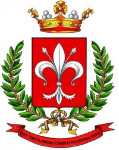Chiesa di S. Francesco
Ultimo aggiornamento: 18 ottobre 2023, 13:55
Chiesa di San Francesco
Inizialmente dedicata a San Sebastiano, è appartenuta ai monaci Benedettini fino al 1256, quando la cedettero perchè l’edificio era deteriorato.
Fu rilevata dai Frati Minori Francescani, che la ripristinarono con non poche difficolà. Nel 1266 la chiesa era completa, tanto che ci giunge memoria che fu scoperchiata durante una della tante azioni violente subite dai frati, che non erano graditi in Città.
Un accordo di pacificazione fu raggiunto nel 1278 e registrato negli Statuti Comunali: nella prima domenica del mese la chiesa sarebbe stata la sede del Consiglio Generale e nel Convento dei Frati si sarebbero conservate le scritture del Comune, a fronte di una elemosina a Natale ed in Agosto (Libro V, rubrica 21).
Fu rilevata dai Frati Minori Francescani, che la ripristinarono con non poche difficolà. Nel 1266 la chiesa era completa, tanto che ci giunge memoria che fu scoperchiata durante una della tante azioni violente subite dai frati, che non erano graditi in Città.
Un accordo di pacificazione fu raggiunto nel 1278 e registrato negli Statuti Comunali: nella prima domenica del mese la chiesa sarebbe stata la sede del Consiglio Generale e nel Convento dei Frati si sarebbero conservate le scritture del Comune, a fronte di una elemosina a Natale ed in Agosto (Libro V, rubrica 21).
Nel 1814 i Francescani vennero sostituiti dai Gesuiti, che ampliarono ulteriormente il convento e il collegio inglobando le abitazioni limitrofe, ed aggiunsero l'affresco dietro l'altare: un fondale con abside e colonne in prospettiva, che crea l'illusione di una maggiore profondità.
Nel 1872, il piano interrato divenne sede del Museo Civico.
Negli anni cinquanta due importanti frane danneggiarono la parte posteriore del palazzo, riducendone di molto la superficie.
Negli anni cinquanta due importanti frane danneggiarono la parte posteriore del palazzo, riducendone di molto la superficie.
La torre campanaria romanica mostra nella base le tracce di una volta a crociera, nel punto in cui era addossata alle costruzioni antecedenti.
Notevole è il prospetto frontale, con l'utilizzo di tecniche decorative molto simili alla vicina Santa Maria Maggiore: grande è la somiglianza nella lavorazione del rosone e nel dettaglio di un identico capitello a quattro teste.
ENG Initially dedicated to San Sebastian, it belonged to the Benedictine monks until 1256.
After deteriorating, it was taken over by the Franciscan Minor Friars, that worked upon it. In 1266, the church was completed: old documents state that its roof was uncovered on purpose during one of the many violent actions suffered by the friars, who were not appreciated in the City.
A settlement was scored in 1278: every month, on the first Sunday, the Church would have been the house for the General Board of the City, and its transcripts would have been kept in the Monastery, in exchange for an alms at Christmas and in August (Book V, heading 21).
A settlement was scored in 1278: every month, on the first Sunday, the Church would have been the house for the General Board of the City, and its transcripts would have been kept in the Monastery, in exchange for an alms at Christmas and in August (Book V, heading 21).
In 1814 the Franciscans were replaced by the Jesuits, who further expanded the convent and college by incorporating the neighboring houses. They also added the fresco behind the altar – a backdrop with apse and columns in perspective, which creates the illusion of greater depth.
In 1872, it was headquarters for the first public collection of archeological findings, classified in a Civic Museum.
In the 1950s, two major landslides damaged the rear of the building, greatly reducing its volume and usage.
The Romanesque bell tower’s base shows the traces of a cross vault, point in which the tower was linked to the earlier buildings.
On the facade we recognize similarities in shapes and techniques used for the nearby Cistercian Church of Santa Maria Maggiore: the rose window is very well chiseled, and peculiar is the presence of an identical four-headed capital.

